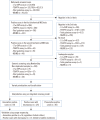A Population-Based Genomic Study of Inherited Metabolic Diseases Detected Through Newborn Screening
- PMID: 27578510
- PMCID: PMC5011110
- DOI: 10.3343/alm.2016.36.6.561
A Population-Based Genomic Study of Inherited Metabolic Diseases Detected Through Newborn Screening
Abstract
Background: A newborn screening (NBS) program has been utilized to detect asymptomatic newborns with inherited metabolic diseases (IMDs). There have been some bottlenecks such as false-positives and imprecision in the current NBS tests. To overcome these issues, we developed a multigene panel for IMD testing and investigated the utility of our integrated screening model in a routine NBS environment. We also evaluated the genetic epidemiologic characteristics of IMDs in a Korean population.
Methods: In total, 269 dried blood spots with positive results from current NBS tests were collected from 120,700 consecutive newborns. We screened 97 genes related to NBS in Korea and detected IMDs, using an integrated screening model based on biochemical tests and next-generation sequencing (NGS) called NewbornSeq. Haplotype analysis was conducted to detect founder effects.
Results: The overall positive rate of IMDs was 20%. We identified 10 additional newborns with preventable IMDs that would not have been detected prior to the implementation of our NGS-based platform NewbornSeq. The incidence of IMDs was approximately 1 in 2,235 births. Haplotype analysis demonstrated founder effects in p.Y138X in DUOXA2, p.R885Q in DUOX2, p.Y439C in PCCB, p.R285Pfs*2 in SLC25A13, and p.R224Q in GALT.
Conclusions: Through a population-based study in the NBS environment, we highlight the screening and epidemiological implications of NGS. The integrated screening model will effectively contribute to public health by enabling faster and more accurate IMD detection through NBS. This study suggested founder mutations as an explanation for recurrent IMD-causing mutations in the Korean population.
Keywords: Epidemiology; Founder mutation; Incidence; Inherited metabolic disease; Newborn screening; Next-generation sequencing.
Conflict of interest statement
Authors' Disclosures of Potential Conflicts of Interest: No potential conflicts of interest relevant to this article were reported.
Figures


Similar articles
-
Combined biochemical profiling and DNA sequencing in the expanded newborn screening for inherited metabolic diseases: the experience in an Italian reference center.Orphanet J Rare Dis. 2025 Jan 24;20(1):38. doi: 10.1186/s13023-025-03546-1. Orphanet J Rare Dis. 2025. PMID: 39856690 Free PMC article.
-
Next-generation sequencing as a second-tier diagnostic test for newborn screening.J Pediatr Endocrinol Metab. 2018 Aug 28;31(8):927-931. doi: 10.1515/jpem-2018-0088. J Pediatr Endocrinol Metab. 2018. PMID: 30030962
-
A New Integrated Newborn Screening Workflow Can Provide a Shortcut to Differential Diagnosis and Confirmation of Inherited Metabolic Diseases.Yonsei Med J. 2018 Jul;59(5):652-661. doi: 10.3349/ymj.2018.59.5.652. Yonsei Med J. 2018. PMID: 29869463 Free PMC article.
-
Insights into National Laboratory Newborn Screening and Future Prospects.Medicina (Kaunas). 2022 Feb 11;58(2):272. doi: 10.3390/medicina58020272. Medicina (Kaunas). 2022. PMID: 35208595 Free PMC article. Review.
-
Inborn errors of metabolism and expanded newborn screening: review and update.Crit Rev Clin Lab Sci. 2013 Nov;50(6):142-62. doi: 10.3109/10408363.2013.847896. Crit Rev Clin Lab Sci. 2013. PMID: 24295058 Review.
Cited by
-
Genetic screening techniques and diseases for neonatal genetic diseases.Zhejiang Da Xue Xue Bao Yi Xue Ban. 2021 Aug 25;50(4):429-435. doi: 10.3724/zdxbyxb-2021-0288. Zhejiang Da Xue Xue Bao Yi Xue Ban. 2021. PMID: 34704410 Free PMC article. English.
-
Genetic background and clinical characteristics of infantile hyperammonemia.Transl Pediatr. 2023 May 30;12(5):882-889. doi: 10.21037/tp-22-359. Epub 2023 Apr 24. Transl Pediatr. 2023. PMID: 37305718 Free PMC article.
-
The Use of Whole Genome and Exome Sequencing for Newborn Screening: Challenges and Opportunities for Population Health.Front Pediatr. 2021 Jul 19;9:663752. doi: 10.3389/fped.2021.663752. eCollection 2021. Front Pediatr. 2021. PMID: 34350142 Free PMC article. Review.
-
Mutation Spectrum of STAR and a Founder Effect of the p.Q258* in Korean Patients with Congenital Lipoid Adrenal Hyperplasia.Mol Med. 2017 Jul;23:149-154. doi: 10.2119/molmed.2017.00023. Epub 2017 May 2. Mol Med. 2017. PMID: 28467518 Free PMC article.
-
Systematic literature review and meta-analysis on the epidemiology of methylmalonic acidemia (MMA) with a focus on MMA caused by methylmalonyl-CoA mutase (mut) deficiency.Orphanet J Rare Dis. 2019 Apr 25;14(1):84. doi: 10.1186/s13023-019-1063-z. Orphanet J Rare Dis. 2019. PMID: 31023387 Free PMC article.
References
-
- Feuchtbaum L, Carter J, Dowray S, Currier RJ, Lorey F. Birth prevalence of disorders detectable through newborn screening by race/ethnicity. Genet Med. 2012;14:937–945. - PubMed
-
- Yoon HR, Lee KR, Kang S, Lee DH, Yoo HW, Min WK, et al. Screening of newborns and high-risk group of children for inborn metabolic disorders using tandem mass spectrometry in South Korea: a three-year report. Clin Chim Acta. 2005;354:167–180. - PubMed
-
- Zytkovicz TH, Fitzgerald EF, Marsden D, Larson CA, Shih VE, Johnson DM, et al. Tandem mass spectrometric analysis for amino, organic, and fatty acid disorders in newborn dried blood spots: a two-year summary from the New England Newborn Screening Program. Clin Chem. 2001;47:1945–1955. - PubMed
-
- Wilcken B, Wiley V, Hammond J, Carpenter K. Screening newborns for inborn errors of metabolism by tandem mass spectrometry. N Engl J Med. 2003;348:2304–2312. - PubMed
-
- Schulze A, Lindner M, Kohlmüller D, Olgemöller K, Mayatepek E, Hoffmann GF. Expanded newborn screening for inborn errors of metabolism by electrospray ionization-tandem mass spectrometry: results, outcome, and implications. Pediatrics. 2003;111:1399–1406. - PubMed
MeSH terms
Substances
LinkOut - more resources
Full Text Sources
Other Literature Sources
Medical
Research Materials
Miscellaneous

